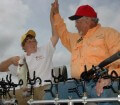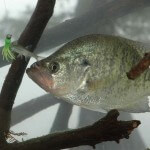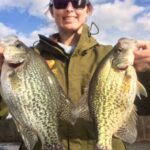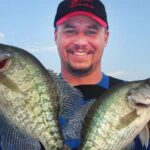John’s Note: Crappie don’t die after the spawn. But most of the time, you’ll have a difficult time finding them and seldom in shallow water. Some of the best crappie fishermen in the South have shared their secrets with us for catching crappie in weather so hot, eggs almost can fry on the sidewalk.
Secrets for Catching Dog-Day Crappie:
 Roger Gant (731-689-5666) of Corinth, Mississippi, has fished Pickwick Lake on the Tennessee River for more than 40 years where he consistently catches limits of slab-sized crappie. When the weather turns hot, crappie move to the heaviest structure they can find – brush piles, underwater trees and stumps. These special tactics from Gant not only work on Dog Day crappie but also can take crappie year-round.
Roger Gant (731-689-5666) of Corinth, Mississippi, has fished Pickwick Lake on the Tennessee River for more than 40 years where he consistently catches limits of slab-sized crappie. When the weather turns hot, crappie move to the heaviest structure they can find – brush piles, underwater trees and stumps. These special tactics from Gant not only work on Dog Day crappie but also can take crappie year-round.
* “Use the proper equipment,” Gant emphasizes. “Many crappie fishermen don’t use the best equipment for the time of year they plan to fish. I can set the hook hard on 8-pound-test line. This small line also will cut through the water, and the jigs will run at the proper depths on it. Too, a crappie fisherman needs an extremely-soft rod yet with enough backbone to hold itself upright. I like a sensitive B ‘n’ M 6-1/2-foot crappie jig pole to spot the lightest crappie bite. I prefer to use a casting reel to count my line down to the proper water depth to catch the crappie. I’ll put a white piece of tape on my rod 1 foot from where the line comes out of the reel. Then if I pull the line off the reel out to where the line crosses the white tape, I know my jig will go down 1-more foot in the water. By having the jigs troll at exactly the water depth or slightly above where the crappie are, we can catch more fish.
 * “Fish the depths where crappie hold by constantly watching your depth finder and searching for fish and structure. Then you’ll know at what depth you need to troll your jigs.
* “Fish the depths where crappie hold by constantly watching your depth finder and searching for fish and structure. Then you’ll know at what depth you need to troll your jigs.
* “Know where crappie hold at the time of year you’re fishing for them. There’s as much structure in the middle of the lake as on the bank. But, the crappie in the middle of the lake experience less fishing pressure and often bite better. By using your depth finder to locate a number of spots in the lake where crappie concentrate during the summer, you can pattern crappie and always know their locations. For instance, to catch crappie in the summer, you must pinpoint areas with heavy structure where you can fish, regardless of the wind. Use your depth finder to locate crappie during the three distinct times of a summer day. Do your early-morning fishing in areas with heavy cover in 12 to 14 feet of water. In mid-morning, fish in 14 to 16 feet of water. In the middle of the day, fish sites with heavy structure in 18 to 22 feet of water.
 * “Remember that crappie holding in different water depths will bite at various times of the day. Crappie don’t move very much in the summer. If you catch crappie for the first 2 hours after daylight, and those crappie stop biting, the crappie probably haven’t moved to deeper water. Those crappie just may have stopped feeding in that spot. At lunchtime you may eat heavily, and then you won’t eat again until dinner, regardless of how much food someone brings to the table. I believe crappie act the same way. To continue to catch fish after they stop biting, go to another spot that has similar structure at a deeper water depth. After 1:00 or 2:00 p.m. when you’ve caught the deepest-water crappie, fish for crappie in more-shallow water again.”
* “Remember that crappie holding in different water depths will bite at various times of the day. Crappie don’t move very much in the summer. If you catch crappie for the first 2 hours after daylight, and those crappie stop biting, the crappie probably haven’t moved to deeper water. Those crappie just may have stopped feeding in that spot. At lunchtime you may eat heavily, and then you won’t eat again until dinner, regardless of how much food someone brings to the table. I believe crappie act the same way. To continue to catch fish after they stop biting, go to another spot that has similar structure at a deeper water depth. After 1:00 or 2:00 p.m. when you’ve caught the deepest-water crappie, fish for crappie in more-shallow water again.”
To learn much more about crappie fishing, get John E. Phillips’ Kindle eBooks and some print books, “Crappie: How to Catch Them Fall & Winter,” “Crappie: How to Catch Them Spring and Summer,” “Catch Cold Water Crappie Now” and “Catch Crappie All Year: Fishing a Single Pole, Using No Boat and Farming Crappie.” Click here to get these books. To receive for free the “Crappie Catchers’ Cookbook,” by John and Denise Phillips that offers free recipes, click here.










